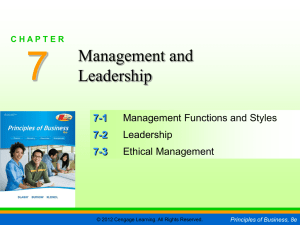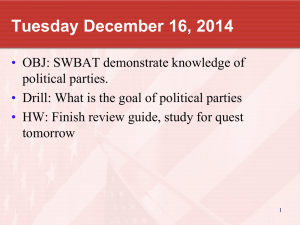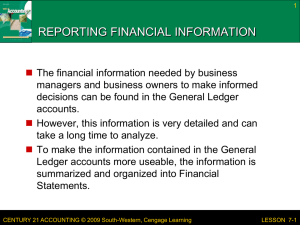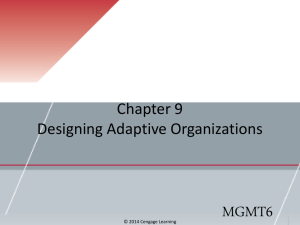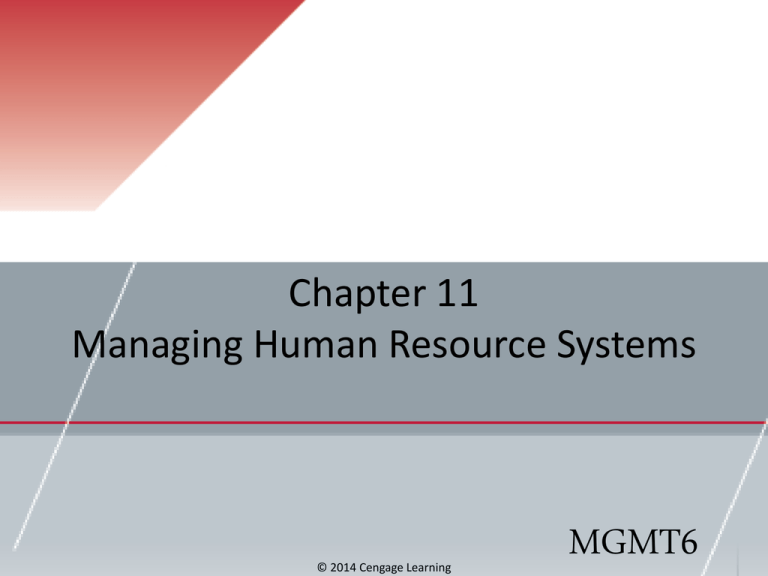
Chapter 11
Managing Human Resource Systems
© 2014 Cengage Learning
MGMT6
11-1 explain how different employment laws affect human
resource practice
11-2 explain how companies use recruiting to find qualified
job applicants
11-3 describe the selection techniques and procedures that
companies use when deciding which applicants should
receive job offers
11-4 describe how to determine training needs and select
the appropriate training methods
11-5 discuss how to use performance appraisal to give
meaningful performance feedback
11-6 describe basic compensation strategies and discuss the
four kinds of employee separations
© 2014 Cengage Learning
© 2014 Cengage Learning
Federal Employment Laws
Employers may not discriminate in employment
decisions based on sex, age, religion, color,
national origin, race, disability.
Bona fide occupational qualification (BFOQ)
“reasonably necessary to the normal operation of
that particular business.”
© 2014 Cengage Learning
11-1
Major Federal
Employment Laws
•
•
•
•
•
•
•
•
Equal Pay Act of 1963
Title VII of the Civil Rights Act of 1964
Age Discrimination in Employment Act of 1967
Pregnancy Discrimination Act of 1978
Americans with Disabilities Act of 1990
Civil Rights Act of 1991
Family and Medical Leave Act of 1993
Uniformed Services Employment and Reemployment
Rights Act of 1994
© 2014 Cengage Learning
11-1
Adverse Impact and
Employment Discrimination
• Disparate treatment
• Adverse impact
• The four-fifths rule
11-1
© 2014 Cengage Learning
Sexual Harassment
A form of discrimination in which unwelcome
sexual advances, request for sexual favors, or
other verbal or physical conducts of a sexual
nature occurs.
•Quid pro quo sexual harassment
•Hostile work environment
© 2014 Cengage Learning
11-1
What Should Managers Do?
• Respond immediately
• Write a clear sexual harassment policy
• Establish clear reporting procedures
• Be aware of local and state laws and
enforcement agencies
© 2014 Cengage Learning
11-1
Job Analysis and Recruiting
A purposeful, systematic process for collecting
information on the important work-related
aspects of a job.
•Work activities
•Tools and equipment used to do to the job
•Context in which the job is performed
•The personnel requirements for performing the
job
© 2014 Cengage Learning
11-2
Results of Job Analysis
• Job description
– a written description of the basic tasks, duties,
and responsibilities required of an employee
holding a particular job
• Job specification
– a summary of the qualifications needed to
successfully perform a job
© 2014 Cengage Learning
11-2
Using Job Analysis,
Descriptions, Specifications
• Used throughout the staffing process to
ensure that selection devices and
decisions are job-related.
• Job analyses, descriptions, and
specifications help companies meet legal
requirements that HR decisions be jobrelated.
© 2014 Cengage Learning
11-2
Internal Recruiting
The process of developing a pool of
qualified job applicants from people who
already work within the company.
• Job posting
• Career path
© 2014 Cengage Learning
11-2
External Recruiting
Process of developing a pool of
qualified job applicants from outside
the company.
•Advertising
•Employee referrals
•Walk-ins
•Outside organizations
•Employment services
•Special events
•Internet job sites
11-2
© 2014 Cengage Learning
Selection
• Selection
– the process of gathering information
about job applicants to decide who should
be offered a job
• Validation
– the process of determining how well a
selection test or procedures predict
future job performance
© 2014 Cengage Learning
11-3
Application Forms and Résumés
• Application forms may only ask for
valid, job-related information
• Résumés pose a problem because of
false data.
© 2014 Cengage Learning
11-3
References and
Background Checks
• Employment references
– contacting previous employers or coworkers to
learn more about the candidate
• Background checks
– used to verify accuracy of information that
applicants provide about themselves
© 2014 Cengage Learning
11-3
Getting Background Information
• Conduct criminal record checks
• Ask applicants to sign a waiver to check
references, run a background check, or
contact people with knowledge of work
history
• Ask applicants if there is anything they
want the company to know
• Consider hiring a private investigator
© 2014 Cengage Learning
11-3
Selection Tests
Specific ability tests
Cognitive ability tests
Biographical data (biodata)
Work sample tests (performance
tests)
• Assessment centers
•
•
•
•
– in-basket exercise
– leaderless group discussion
11-3
© 2014 Cengage Learning
© 2014 Cengage Learning
11-3
© 2014 Cengage Learning
11-3
Interviews
• Unstructured interviews
• Structured interviews
• Semistructured interviews
© 2014 Cengage Learning
11-3
Structured Interview Questions
• Situational questions
• Behavioral questions
• Background questions
• Job-knowledge questions
© 2014 Cengage Learning
11-3
© 2014 Cengage Learning
11-3
Training and Training Needs
• Training
– providing opportunities for employees to
develop the job-specific skills, experience,
and knowledge they need to do their jobs
or improve their performance
• Needs assessment
– the process of identifying and prioritizing
the learning needs of employees
© 2014 Cengage Learning
11-4
© 2014 Cengage Learning
11-4
E-Learning
• Advantages
– reduce travel costs
– increase productivity
– decrease employee stress
• Disadvantages
– not always the appropriate method
– not effective for changing behavior or developing problemsolving skills
– require significant investment in technology
– many employees find it boring and unengaging
© 2014 Cengage Learning
11-4
Evaluating Training
• Reactions
• Learning
• Behavior
• Results
© 2014 Cengage Learning
11-4
Performance Appraisal
The process of appraising how well
employee are doing their jobs.
© 2014 Cengage Learning
11-5
Accurately Measuring
Job Performance
• Objective performance measures
– measures of performance that are easily
and directly counted or quantified (output,
scrap, sales, etc)
• Subjective performance measures
– require that someone judge or assess a
worker’s performance
© 2014 Cengage Learning
11-5
© 2014 Cengage Learning
11-5
Rater Training
• Frame-of-reference training
– a group of trainees learns how to do
performance appraisals by watching a video of
an employee at work and then evaluating the
person’s performance
– a trainer shares his or her evaluations, and
trainees’ evaluations are compared with
experts’
– expert explains his or her evaluation
– process repeated until the differences are
minimized
© 2014 Cengage Learning
11-5
Sharing Performance Feedback
• 360-degree feedback
– feedback comes from four sources:
the boss, subordinates, peers and
coworkers, and the employees
themselves
11-5
© 2014 Cengage Learning
© 2014 Cengage Learning
11-5
Improving Performance Reviews
• Separate developmental feedback from
administrative feedback
• Performance appraisal feedback sessions
should be based on employee selfappraisals
• What people do with the feedback matters;
it helps if people discuss their performance
feedback with others, and discuss it with
people who provided it
© 2014 Cengage Learning
11-5
Compensation
The financial and nonfinancial rewards
that organizations give employees in
exchange for their work.
© 2014 Cengage Learning
11-6
Compensation Decisions
Pay-level decisions
• Decisions about whether to pay workers
at a level above, below, or at current
market wages.
• Job evaluation
– determines the worth of each job by
determining market value of skills
required to perform it
© 2014 Cengage Learning
11-6
Compensation Decisions
Pay-variability decisions
• The extent to which employees’ pay varies
with individual and company
performance
•
•
•
•
•
11-6
Piecework
Commission
Profit sharing
Employee stock ownership plans (ESOP)
Stock options
© 2014 Cengage Learning
Compensation Decisions
Pay-structure decisions
• Concerned with internal pay
distribution
• Hierarchical pay structures
• Compressed pay structures
© 2014 Cengage Learning
11-6
Employment Separation
A broad term covering the loss of an
employee for any reason.
•Involuntary separation
•Voluntary separation
© 2014 Cengage Learning
11-6
Terminating Employees
• In most situations, firing should not be
the first option.
• Employees should be fired only for a
good reason (wrongful discharge).
• Employees should always be fired in
private.
© 2014 Cengage Learning
11-6
Downsizing
The planned elimination of jobs in a
company.
May actually decrease productivity and
lead to loss of skilled workers.
© 2014 Cengage Learning
11-6
Guidelines for
Conducting Layoffs
•
•
•
Provide clear reasons and explanations for the layoffs.
To avoid laying off employees with critical or irreplaceable
skills, knowledge, and expertise, get input from human
resources, the legal department, and several levels of
management.
Train managers in how to tell employees that they are being
laid off (i.e., stay calm; make the meeting short; explain why,
but don’t be personal; and provide information about
immediate concerns such as benefits, finding a new job, and
collecting personal goods).
© 2014 Cengage Learning
11-6
Guidelines for
Conducting Layoffs
• Give employees the bad news early in the day, and
try to avoid laying off employees before holidays.
• Provide outplacement services and counseling to
help laid-off employees find new jobs.
• Communicate with employees who have not been
laid off to explain how the company and their jobs
will change.
© 2014 Cengage Learning
11-6
Retirement
• Early retirement incentive program
(ERIP)
– offer financial benefits to employees to
encourage them to retire early.
– reduces number of employees, lowers costs,
creates new openings
• Phased retirement
– employees transition to retirement by working
reduced hours before completely retiring
© 2014 Cengage Learning
11-6
Employee Turnover
The loss of employees who choose to leave
the company.
•Functional turnover
•Dysfunctional turnover
© 2014 Cengage Learning
11-6
Barcelona Restaurant
Group
1.
2.
3.
<click screenshot for video>
List the three main activities of
human resource management
(HRM) and identify which activity is
examined at length in the video.
Of the various steps in Barcelona’s
employee selection process, the job
interview is the most brief. Do you
agree with the company’s approach
to interviewing? Why or why not?
Describe Barcelona’s three-stage
process for matching job applicants
with its organizational objectives,
and explain how each stage reveals
the fit between job applicants and
the needs of the restaurant.
© 2014 Cengage Learning






